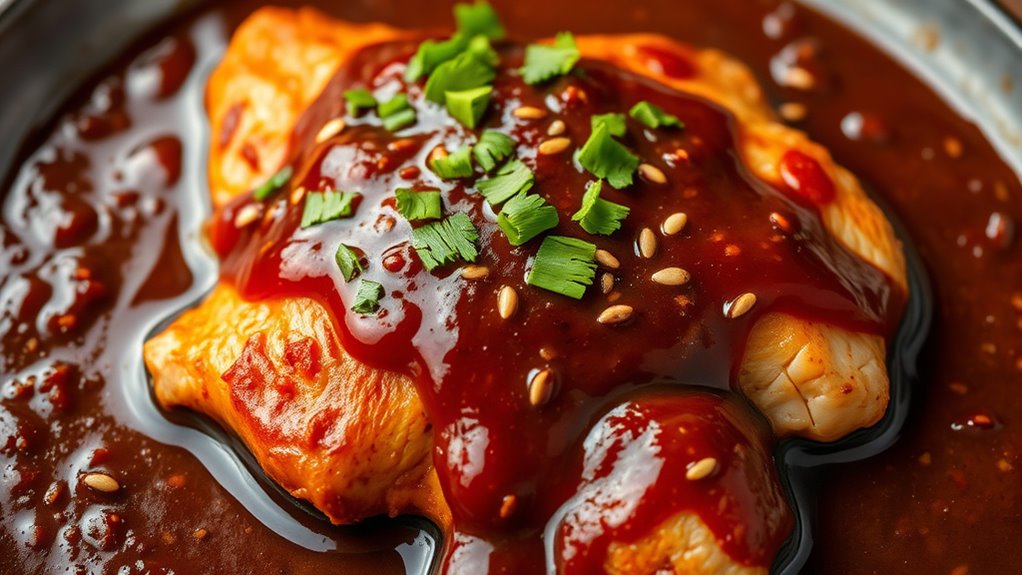To balance sweet, smoky, and spicy flavors in Mexican mole, start by carefully selecting your chilies—soaking or charring them to control heat and bring out smoky notes. Add chocolate, dried fruits, and warm spices slowly, tasting as you go to guarantee harmony. Using sweeteners like honey or sugar can mellow spice, while acidity from lime or vinegar brightens flavors. If you want to master this craft, there’s more to discover below.
Key Takeaways
- Toast and soak dried chilies to soften heat and develop smoky, complex flavors before blending into the mole.
- Use a variety of chilies (ancho, chipotle) to achieve a balanced smoky and spicy profile.
- Incorporate small amounts of sweeteners like honey, sugar, or raisins to mellow spiciness and enhance sweetness.
- Add acidity such as lime juice or vinegar to brighten flavors and reduce perceived spiciness.
- Extend simmering and adjust chili quantities gradually to refine heat levels and deepen overall flavor harmony.
The Rich History and Cultural Significance of Mexican Mole
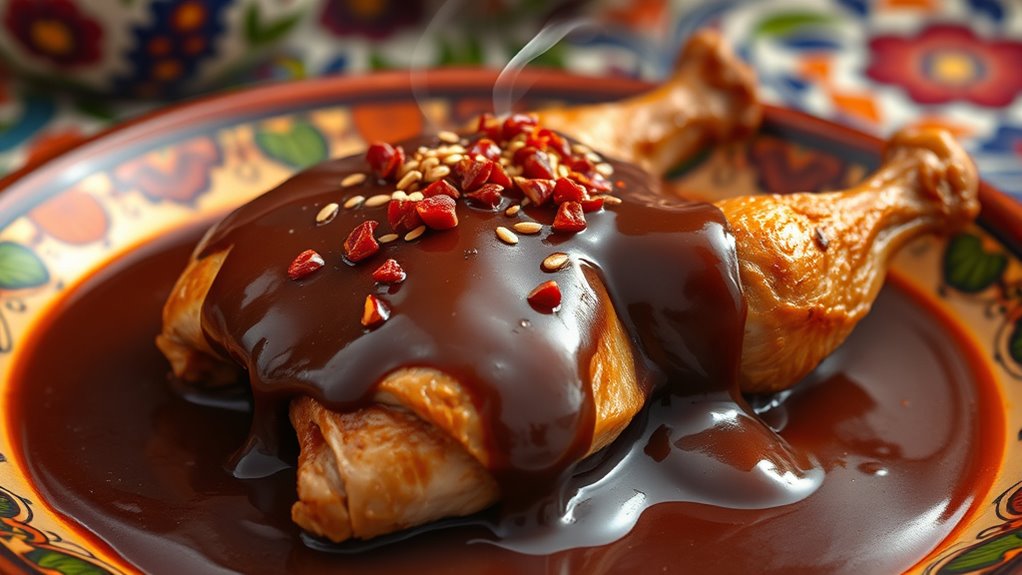
Mexican mole has a rich history that dates back centuries, reflecting the deep cultural roots of the region. You’ll find that it’s more than just a sauce; it’s a symbol of tradition, family, and community. Historically, mole was reserved for special occasions and religious ceremonies, showcasing its significance in Mexican culture. Indigenous peoples, such as the Aztecs and Maya, used local ingredients like chilies and cacao, laying the foundation for the complex flavors we enjoy today. Over time, different regions developed their own versions, passing recipes through generations. The cultural significance of mole continues to be celebrated in festivals and family gatherings across Mexico. By savoring mole, you’re connecting with a centuries-old culinary heritage that embodies Mexico’s history, spirituality, and social fabric. It’s a dish that celebrates identity, resilience, and the artistry of Mexican cuisine, which often involves traditional cooking methods that preserve its authentic flavors. Additionally, the craftsmanship involved in preparing mole highlights the importance of culinary tradition, reflecting the intergenerational transfer of recipes and techniques that maintain cultural identity. This culinary heritage also emphasizes the importance of local ingredients and regional variations, further enriching its cultural importance.
Essential Ingredients That Define Mole’s Flavor Profile
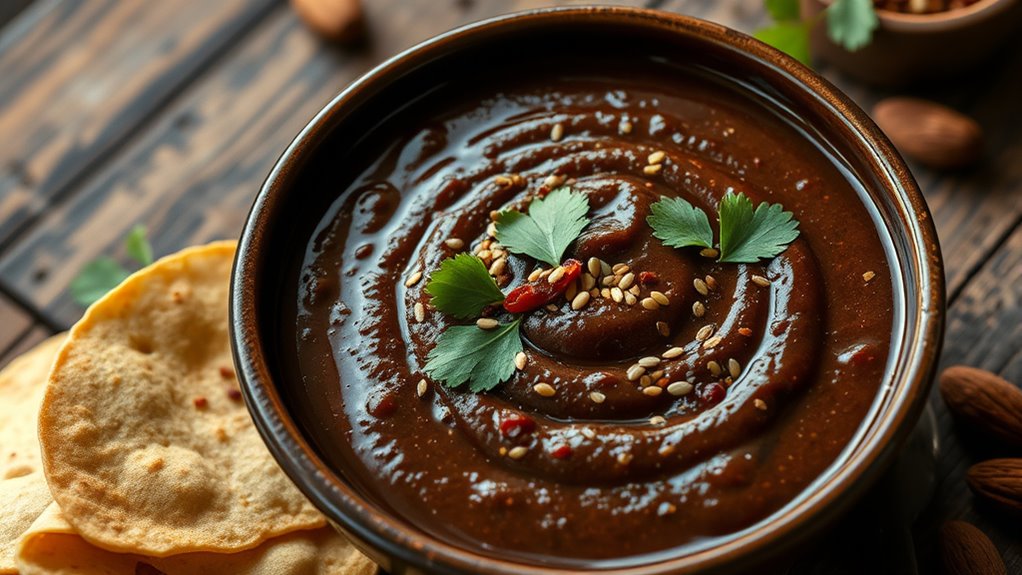
The rich history of mole is reflected in its complex and layered flavor profile, which results from a carefully selected blend of ingredients. You’ll find toasted spices like cumin, cinnamon, and cloves that add warmth and depth. Nutty elements such as almonds or sesame seeds contribute richness, while dried fruits like raisins or prunes introduce subtle sweetness. Unsweetened chocolate or cacao powder provides a smoky, earthy note that balances the sweetness. Vegetables like tomatoes and onions create a savory base, and herbs like oregano and thyme add fresh, aromatic accents. Each ingredient plays an essential role, harmonizing to produce the unique, multifaceted taste that makes mole a true culinary masterpiece. The culinary tradition behind mole influences the selection of ingredients, ensuring each recipe has its own distinctive character. A refined palate can appreciate how these ingredients come together to create a harmonious flavor profile. Your careful choice and combination of these ingredients define its unforgettable flavor.
Understanding the Role of Chilies in Achieving the Perfect Balance
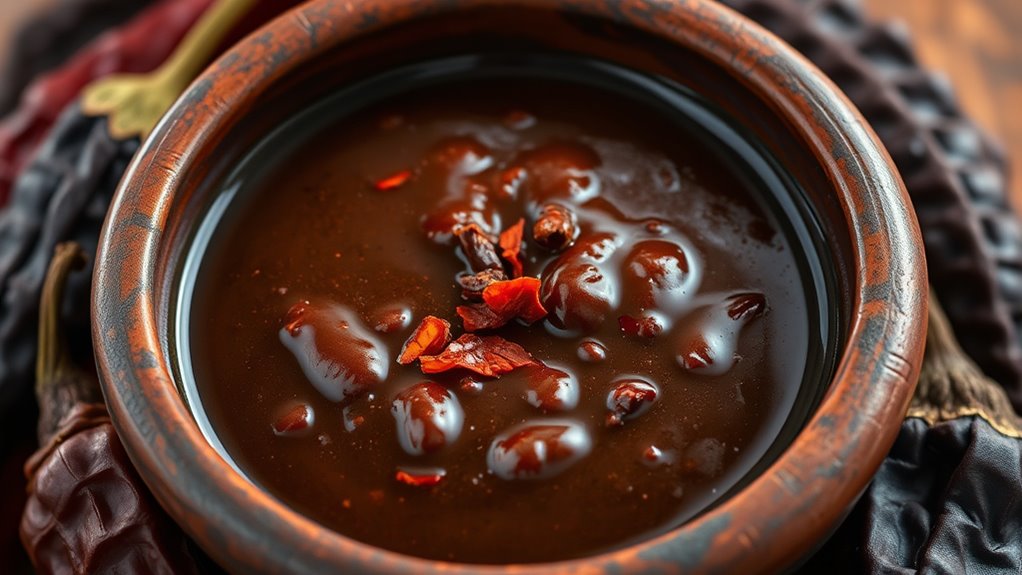
Have you ever wondered how chilies balance heat and flavor in mole? Chilies are the heart of mole, bringing both spice and depth. Their role is to add warmth without overpowering other ingredients, creating harmony. To achieve this, you need to consider:
- Variety – Different chilies, like ancho or chipotle, contribute unique smoky and sweet notes that complement each other.
- Quantity – Using the right amount controls the heat level, ensuring it enhances rather than dominates.
- Preparation – Toasting or soaking chilies softens their heat and releases flavors, blending them seamlessly into the sauce.
- Sustainability considerations – Choosing chilies grown with ethical farming practices can influence flavor profiles and support environmentally friendly cultivation.
Mastering these elements helps you craft a mole that’s balanced—spicy yet nuanced, vibrant yet smooth. Chilies are the key to revealing the perfect flavor harmony.
The Impact of Chocolate and Sweet Elements in Mole
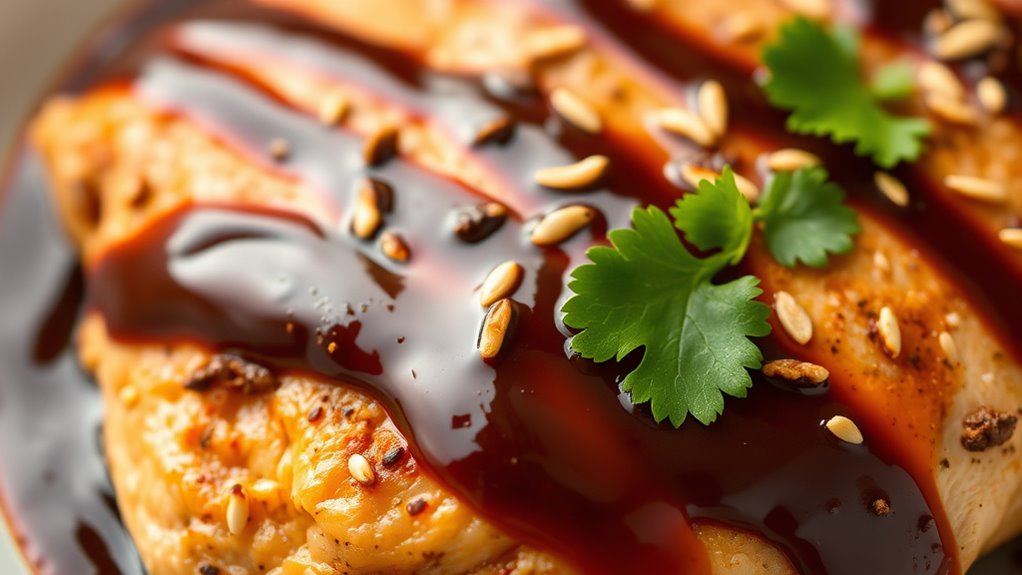
While chilies provide heat and depth, adding chocolate and sweet elements introduces a complex richness that balances those spicy notes. The sweetness softens the chili’s intensity, creating harmony in your mole. Chocolate, often dark and bittersweet, adds a velvety texture and a subtle earthiness that deepens the flavor profile. Imagine these elements working together:
| Sweet Element | Flavor Contribution | Sensory Effect |
|---|---|---|
| Dark Chocolate | Depth, bitterness | Velvety richness |
| Raisins | Natural sweetness | Slight fruitiness |
| Cinnamon | Warm spice | Comforting aroma |
| Brown Sugar | Caramel undertones | Smooth, mellow finish |
This blend transforms a fiery sauce into a layered, indulgent experience that delights your palate. Additionally, the color accuracy of the ingredients and their presentation can enhance the visual appeal of your dish, making it even more appetizing.
Techniques for Achieving the Ideal Smoky Flavor
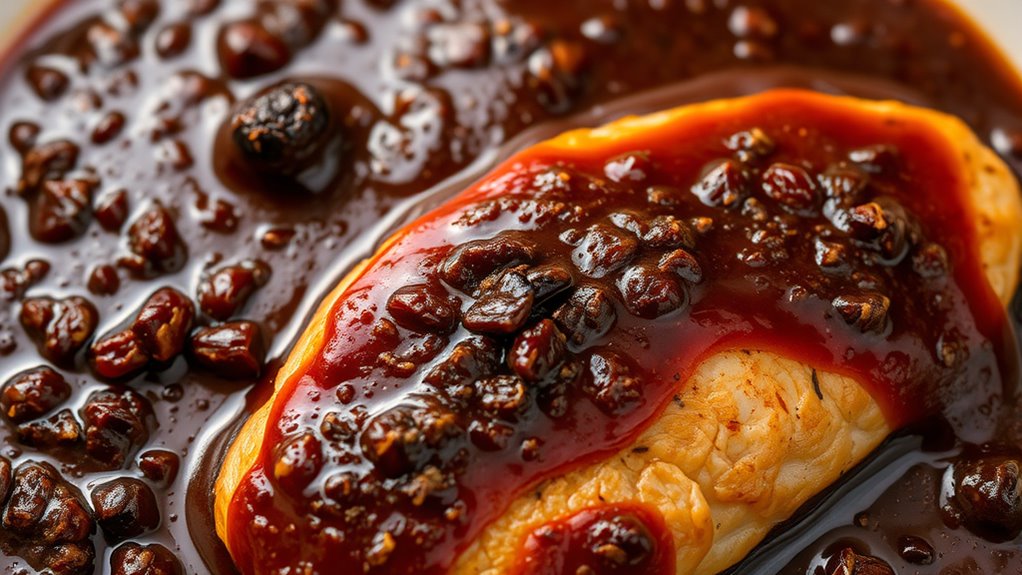
To infuse your mole with an authentic smoky depth, you need to incorporate techniques that enhance the natural flavors of the ingredients. First, consider charring dried chiles before blending; this adds a rich, smoky aroma. Second, use wood smoke or a grill to toast ingredients like tomatoes and spices, imparting deeper flavor layers. Third, incorporate smoked spices such as smoked paprika or chipotle powder, which naturally carry smoky notes. These methods help develop a complex, smoky profile that complements the sweetness and spice. Additionally, sound healing science can inspire creative presentation, adding a visual element to your culinary display. Remember, moderation is key—too much smoke can overpower other flavors. Incorporating diverse beach experiences can also inspire a variety of flavor combinations and presentation styles that elevate the dish. Furthermore, understanding the traditional techniques of butter making can guide you in applying complementary smoky textures to your dishes, enhancing overall flavor harmony. Exploring smoking methods can further refine your technique and deepen the smoky flavor profile. Combining these techniques guarantees your mole has an authentic, well-rounded smoky essence that elevates the dish.
Tips for Adjusting Spiciness to Suit Your Taste
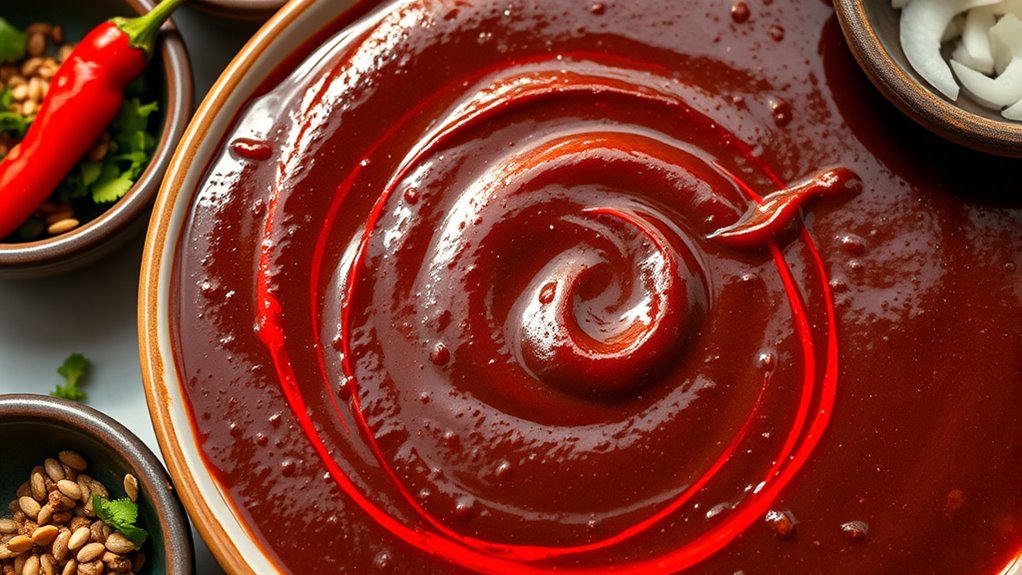
To make your mole spicier or milder, start by adjusting the amount of chili you use. If it’s too hot, try adding a touch of sweetness or a splash of acid to balance the heat. You can also control spiciness by changing the cooking time, which can mellow or intensify the flavors. Incorporating heat pump technology like simmering can help adjust the overall flavor profile of the dish. Additionally, choosing dairy-free options such as plant-based ingredients can subtly alter the creaminess and balance of flavors in your mole.
Modify Chilli Quantities
Adjusting the amount of chili in your Mexican mole allows you to customize its heat level to match your preference. If you want milder flavor, reduce the chili quantity gradually, tasting as you go. Conversely, if you crave more spice, add small amounts of chili and wait for the heat to develop before adding more. Here are some tips to help you modify chili quantities effectively:
- Start small—it’s easier to add more chili than to tone down excessive spiciness.
- Consider the type of chili—some are hotter than others, so adjust accordingly.
- Balance heat with other ingredients—incorporate sweetness or acidity to mellow or enhance spiciness.
Use Sweeteners or Acid
When your mole turns out too spicy, adding a touch of sweetness or acidity can help mellow the heat and bring balance to the flavors. For sweetness, try stirring in a small amount of honey, sugar, or agave nectar—start with a teaspoon and taste as you go. These sweeteners counteract the spice and enhance the richness of the sauce. If you prefer acidity, add a splash of lime juice or vinegar, which brightens the flavors and cuts through the heat. Be cautious—add small amounts gradually, tasting after each addition to avoid overpowering the dish. Both options work well to tone down spiciness without compromising the complex, layered flavors that make mole so special. Adjust slowly for the perfect flavor balance. Incorporating cooking techniques can further refine the taste to suit your preferences. Using essential oils with a gentle, natural touch can also enhance the overall aroma and depth of your mole.
Adjust Cooking Time
If your mole is too spicy, one effective way to tame the heat is by modifying the cooking time. Extending the simmering process allows flavors to meld and can mellow the spiciness. Longer cooking breaks down heat compounds, making the dish less intense. To adjust effectively:
- Simmer longer—let it cook on low heat for an extra 10-15 minutes, stirring occasionally.
- Add liquid—introduce more broth or water to dilute the spiciness gradually.
- Taste and adjust—try the mole periodically to gauge the heat level, stopping when it reaches your preferred balance.
- Incorporating proper maintenance into your adjustments can help you refine the perfect flavor profile.
Step-by-Step Guide to Making Authentic Mole at Home
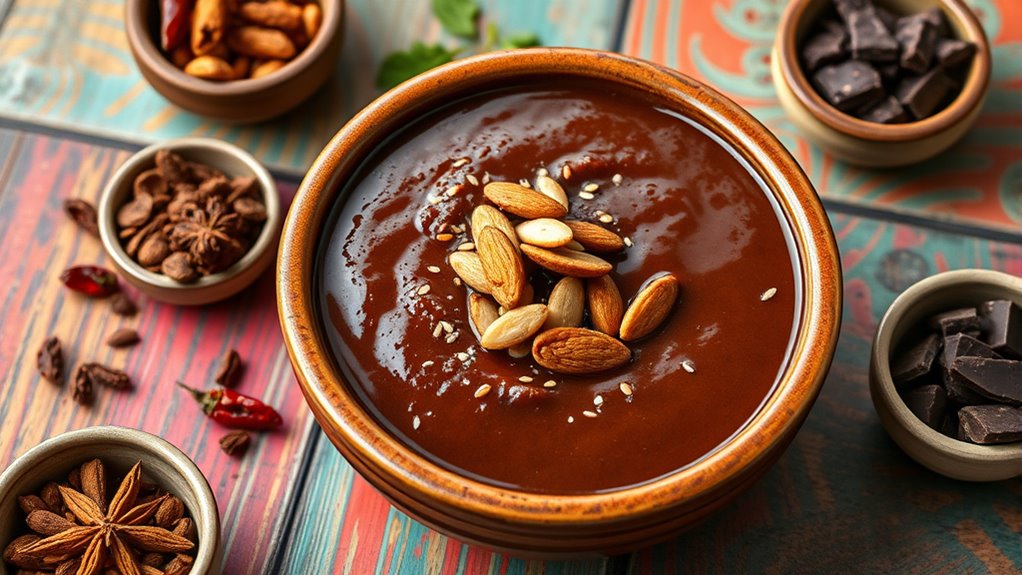
Making authentic Mexican mole at home may seem intimidating, but with the right steps, it becomes an achievable and rewarding process. Start by gathering ingredients like dried chiles, spices, nuts, and chocolate. Toast and soak chiles, then blend them with your other ingredients until smooth. Simmer the sauce to develop its rich flavors, stirring occasionally. Use a blender for smoothing, and strain if needed for a velvety texture. Keep tasting and adjusting seasonings as you go. Here’s a quick overview:
| Step | Action | Tip |
|---|---|---|
| Prepare ingredients | Toast chiles and spices, soak chiles | Enhance flavor and aroma |
| Blend | Combine chiles, nuts, spices, chocolate | Achieve smooth consistency |
| Simmer | Cook sauce over low heat | Develop depth and richness |
| Adjust & Serve | Taste, adjust seasoning, serve over chicken | Balance flavors before serving |
Pairing and Serving Suggestions to Highlight Mole’s Complex Flavors
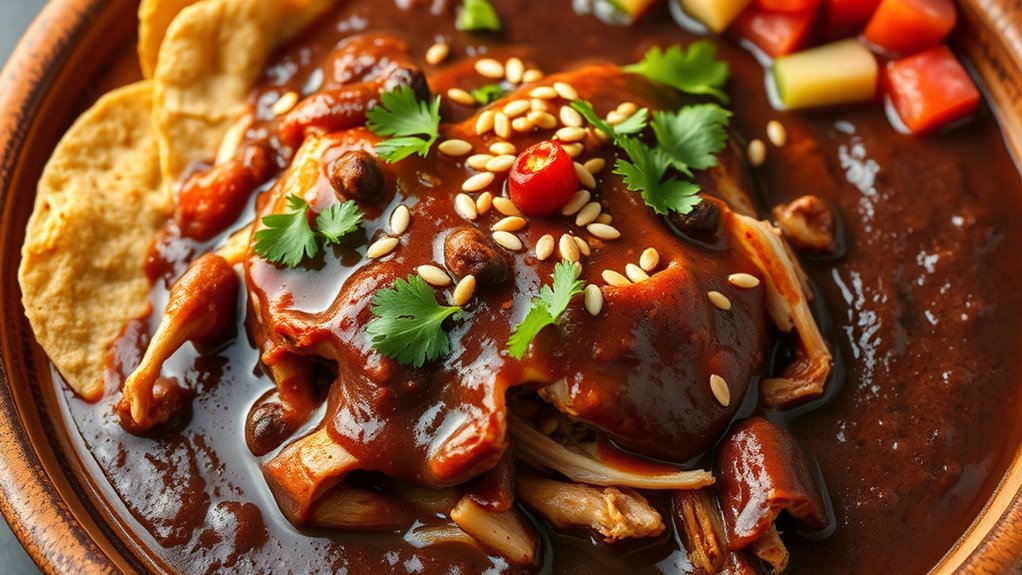
To truly appreciate the depth and complexity of Mexican mole, pairing it with the right dishes and accompaniments can elevate your dining experience. The key is balancing flavors to enhance the mole’s sweet, smoky, and spicy notes. First, serve it over tender chicken or turkey—the mild meat provides a perfect canvas for the sauce’s richness. Second, accompany your dish with warm corn tortillas, which help mellow the heat and soak up the sauce. Third, add a side of pickled vegetables or fresh cilantro to cut through the richness and add brightness. These combinations not only complement the mole’s bold flavors but also create a harmonious balance on your plate, making each bite a delightful exploration of taste and tradition.
Frequently Asked Questions
What Are Common Variations of Mexican Mole Across Regions?
When exploring regional variations of Mexican mole, you notice how each area adds its unique touch. In Oaxaca, you find rich, chocolatey moles with ingredients like hoja santa, while in Puebla, you encounter the complex, layered moles like mole poblano with chili peppers and chocolate. Yucatán moles focus on fruit and citrus, and Guerrero offers smoky, peppery versions. Each variation reflects local ingredients and culinary traditions, giving you a diverse tasting experience.
How Can I Store Leftover Mole Safely and Effectively?
To store leftover mole safely, transfer it to an airtight container and let it cool completely before refrigerating. You should consume it within 3 to 4 days for ideal freshness. If you want to keep it longer, freeze the mole in a freezer-safe container for up to 3 months. When reheating, do so gently on the stove, stirring well to maintain its rich flavor and texture.
Are There Vegan or Vegetarian Mole Recipes Available?
Yes, you can find many vegan or vegetarian mole recipes. They often substitute traditional ingredients like chicken broth and meat with vegetable broth, nuts, seeds, or plant-based proteins. You might enjoy experimenting with ingredients like roasted peppers, tomatoes, chocolate, and spices, ensuring you still get that rich, complex flavor. Many recipes are available online, making it easy to create a delicious, plant-based mole that balances sweet, smoky, and spicy elements.
How Does Altitude Affect the Cooking Process of Mole?
Altitude impacts how you cook mole by changing boiling points and heat transfer. At higher elevations, water boils faster and at a lower temperature, which means your mole might need extra simmering time to develop flavors fully. You might also need to modify your cooking times or temperature to guarantee ingredients soften properly and flavors meld. Keep an eye on consistency, and don’t hesitate to tweak your recipe for the best results.
Can Mole Be Made in a Slow Cooker or Instant Pot?
You can definitely make mole in a slow cooker or Instant Pot. Imagine preparing a rich, flavorful mole in your slow cooker, allowing the flavors to meld over several hours without constant supervision. For example, a home cook might start in the morning and enjoy a deep, complex sauce by dinner. Both appliances save time and effort, ensuring you get authentic-tasting mole with minimal fuss.
Conclusion
So there you have it—your crash course in mastering Mexican mole, where balancing sweetness, smokiness, and spice is practically an art form. With a dash of patience and a pinch of daring, you’ll soon be impressing everyone with a sauce that’s as complex as your favorite novel. Just remember, if your mole turns out too spicy, it’s a sign you’re officially a culinary rebel. Happy cooking—embrace the chaos!
